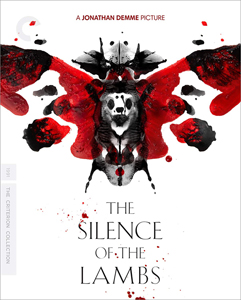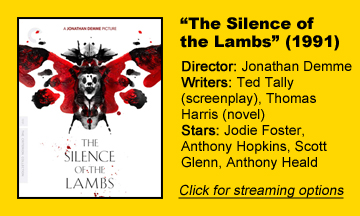To mark the 40th anniversary of author Thomas Harris’ invention of Hannibal Lecter and the 30th anniversary of “The Silence of the Lambs” – the only horror film to win Best Picture – we’re looking back at the four books and five films of the Hannibal Lecter series over nine Frightening Fridays. Next up is the second film, “The Silence of the Lambs” (1991):
Oscar breakthrough
“The Silence of the Lambs” is the only horror movie to win a Best Picture Oscar, and I’ve always resented it a little for that. Why not “Psycho”? Why not “The Exorcist”? After all, those are much scarier, moodier films.
The answer is this, as a Season 1 episode of “Eli Roth’s History of Horror” points out: “Silence” didn’t pitch itself as a horror film in its Oscar politicking, so voters didn’t have to know they were voting for a horror film. So “Silence” earned its unique distinction while also doing nothing to promote wider artistic acceptance of the genre.
Indeed, director Jonathan Demme and writer Ted Tally downplay the visceral scares in favor of psychological drama – although not to the same extreme as “Manhunter.” (Neither film flat-out shows the villain eating part of someone’s face, but at least here we see blood on the eater’s face.)
Perhaps there’s a more horror-centric version of Harris’ work to be made (and maybe the series’ next film, “Hannibal,” will address that). But for now, I have to admit that “Silence” is at least more horrific than “Manhunter,” and it’s a better film by almost every other metric, too.
A smart, faithful adaptation
It’s not often that the writer of the source material deserves the most credit for a film’s success, but a case could be made that Harris earns that nod here. Tally wisely adapts the 1988 novel faithfully, mixing FBI student Clarice Starling’s (Jodie Foster) first case with Hannibal Lecter’s (Anthony Hopkins) skin-crawling charisma with Buffalo Bill’s (Ted Levine) creepy desire to find the perfect woman suit.
Harris is a master at dreaming up bizarre fetishes for his villains, and Levine – who would go on to a career mostly playing police officers – fits well into a wild role with iconic lines like “Put the lotion in the basket.” I even feel sympathetic for Bill when his captive in the well, Catherine (Brooke Smith, an actress I would’ve liked to see have a bigger career), steals his pooch, Precious.
It doesn’t need to be said again that Hopkins creates an iconic Hannibal Lecter. But he has advantages Brian Cox didn’t. The image of Lecter being carted around in a handcart, a wire mask so tight to his face that it scrunches his nose, make him scary before he actually does anything. And then he has that brilliant escape scene where he wears a victim’s face as a mask.
Foster’s influential turn
Nor does it need to be said that Foster is great, especially at showing a rookie’s unease around Lecter and fear in the showdown with Bill. Again, Harris deserves a nod for devising a sequence that Tally and Demme exploit: Bill seeing Clarice through night vision goggles in the basement.

Foster’s performance as Clarice was an undeniable influence on the creation of “The X-Files’ ” Dana Scully, another young agent who wants to be (and usually is) brave in the face of danger, but is no super action hero. (“Manhunter,” meanwhile, might’ve influenced “Millennium” with the notion of a good guy knowing how the bad guy thinks, but that comparison isn’t as on the nose.)
I wonder if “The X-Files” was subtly influenced in other ways. When Clarice and the two nerdy bug experts lean over a microscope, it’s shot from below, a framing choice that reminds me of the Lone Gunmen.
I’ll let film-class teachers break down Demme’s use of close-ups and framing, but in a nutshell, “Silence” is about people – indeed, the title comes from Clarice’s life-shaping moment when she comes upon lambs being slaughtered.
But it’s not only about Clarice and Hannibal, whose weird friendship is the uneasy core. Supporting characters like Clarice’s boss Jack Crawford (“Daredevil’s” Scott Glenn) and roommate Ardelia (Kasi Lemmons) also get tight framing. Demme uses the spotlight as a given scene warrants.
Yet thanks to the classic suspenseful score from Howard Shore (instead of the synth sounds of the style-dripping “Manhunter”), “Silence” has a wider scope than its more claustrophobic predecessor. It successfully has it both ways: a character piece with broad observations.
We come out of it knowing Clarice and Hannibal as individuals, but we also know how it feels to be an agent trying to make it while young and female, and what cards you can play to gain psychological advantages even when you’re the one in a cage. And we get a feel for the big picture of the FBI working a case, and the steps along the way.
Sympathy for the devil
“Silence” doesn’t quite make us complicit with the villains, but it gives us sympathy for the devil. Interestingly, this might be a side effect of the film shying away from its horror elements. We have the knowledge of the horrors Lecter and Bill committed in the past, but on screen we only see Hannibal’s caged conditions. Although he debuted on screen in “Manhunter,” “Silence” is where he becomes an iconic villain we hate to love.
And in Buffalo Bill we see someone who is obviously psychologically troubled. His initial blow to Charlotte happens off screen, we never actually see him trying on a woman-skin suit (although failed suits are briefly glimpsed), and it’s hard to hate someone who loves animals.
Even in the goggles sequence, Bill takes a long time before deciding to kill Clarice; it’s not something he wants to do. (Meanwhile, Catherine is ungrateful and uncooperative when Clarice arrives at the basement well. She is not the most sympathetic captive. I like Smith’s sweetly expressive face, though, so that softens the edge for me.)
We’re rewarded with the triple happy ending of Catherine being saved, Clarice graduating and Hannibal going free. Maybe it’s even a quadruple happy ending, because Hannibal promises he’s going to eat the most annoying character, Dr. Chilton (“Boston Public’s” Anthony Heald, projecting smarm to the back row).
With its easy stylistic appeal and the slight edginess (by mass audience standards) of a skin-suit-wearing villain, “The Silence of the Lambs” figured out how to thread the needle and make Oscar history as a horror film.
I kind of hate it for that, because it is not the genre’s elite film; rather, it’s the elite horror film that people who dislike horror can like. Still, its craftsmanship – and influence on one of my favorite TV shows — can’t be denied.
IMDb Top 250 trivia
- “The Silence of the Lambs” is the only “Hannibal” film in the Top 250, coming in at No. 23 with an 8.6 rating.
- Among the other films, both adaptations of “Red Dragon” (“Manhunter” and “Red Dragon”) rate a 7.2, “Hannibal” is next at 6.8 and “Hannibal Rising” tallies a 6.2.
- But the “Hannibal” TV series cracks TV’s Top 250, coming in at No. 225 with an 8.5 rating.


